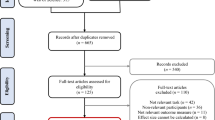Abstract
Separate but parallel lines of theory and research have suggested that heightened self-focused attention is an important factor in both depression and anxiety. While studies have shown increased self-focusing in both of these dysfunctional states, adequate conclusions cannot be drawn because of the high cooccurrence of depressive and anxious affect in studies of this type. The present study separated subjects into depressed and anxious groups and examined levels of self-focused attention on two different measures. Results indicated that both affective states are separately characterized by heightened self-focused attention. These findings suggest conceptual difficulties for theoretical models of either depression or anxiety that separately propose self-focused attention variables as central to these disorders.
Similar content being viewed by others
References
Beck, A. T. (1967).Depression: Clinical experimental and theoretical aspects. New York: Hoeber.
Beck, A. T., & Clark, D. A. (1988). Anxiety and depression: An information processing perspective.Anxiety Research, 1 23–36.
Beck, A. T., Rush, A. J., Shaw, B. F., & Emery, G. (1979).Cognitive therapy of depression. New York: Guilford Press.
Carmer, S. G., & Swanson, M. R. (1973). An evaluation of ten pairwise multiple comparison procedures by Monte Carlo methods.Journal of the American Statistical Association, 341 66–74.
Carver, C. S., & Scheier, M. F. (1981).Attention and self-regulation: A control-theory approach to human behavior. Berlin and New York: Springer-Verlag.
Clark, D. A. (1986). Cognitive-affective interaction: A test of the “specificity” and “generality” hypotheses.Cognitive Therapy and Research, 10 607–624.
Deffenbacher, J. L. (1978). Worry, emotionality, and task-generated interference in test anxiety: An empirical test of attentional theory.Journal of Educational Psychology, 70 248–254.
Fenigstein, A., Scheier, M. F., & Buss, A. H. (1975). Public and private self-consciousness: Assessment and theory.Journal of Consulting and Clinical Psychology, 43 522–527.
Gibbons, F. X. (1983). Self-focused attention and self-report validity: The “veridicality” hypothesis.Journal of Personality, 51 517–542.
Gibbons, F. X. (1987). Mild depression and self-disclosure intimacy: Self and others' perceptions.Cognitive Therapy and Research, 11 361–380.
Gibbons, F. X., Smith, T. W., Ingram, R. E., Pearce, K. Brehm, S. S., & Schroeder, D. J. (1985). Self-awareness and self-confrontation: Effects of self-focused attention on members of clinical population.Journal of Personality and Social Psychology, 48 662–675.
Gotlib, I. H. (1984). Depression and general psychopathology in university students.Journal of Abnormal Psychology, 93 19–30.
Gotlib, I. H., & Cane, D. B. (1989). Self-report assessment of depression and anxiety. In P. C. Kendall & D. Watson (Eds.).Anxiety and depression: Distinctive and overlapping features. Orlando, FL: Academic Press.
Heimberg, R. G., Dodge, C. S., & Becker, R. E. (1987). Social phobia. In L. Michelson & L. M. Ascher (Eds.),Anxiety and stress disorders: Cognitive-behavioral assessment and treatment New York: Guilford Press.
Heimberg, R. G., Vermilyea, J. A., Dodge, C. S., Becker, R. E., & Barlow, D. H. (1987). Attributional style, depression, and anxiety: An evaluation of the specificity of depressive attributions.Cognitive Therapy and Research, 11 537–550.
Hope, D. A., & Heimberg, R. G. (1985).Public and private self-consciousness in a social phobic sample. Paper presented at the meeting of the Association for the Advancement of Behavior Therapy.
Hope, D. A., & Heimberg, R. G. (1988). Public and private self-consciousness and social phobia.Journal pf Personality Assessment, 52 626–639.
Ingram, R. E. (1989). Self-focused attention in clinical disorders: Review and a conceptual model.Psychological Bulletin, in press.
Ingram, R. E., Cruet, D., Johnson, B. R., & Wisnicki, K. S. (1988). Self-focused attention, gender, gender role, and vulnerability to negative affect.Journal of Personality and Social Psychology, 55 967–978.
Ingram, R. E., & Kendall, P. C. (1987). The cognitive side of anxiety.Cognitive Therapy and Research, 11 523–536.
Ingram, R. E., Lumry, A., Cruet, D., & Sieber, W. (1987). Attentional processes in depressive disorders.Cognitive Therapy and Research, 11 351–360.
Ingram, R. E., & Smith, T. W. (1984). Depression and internal versus external focus of attention.Cognitive Therapy and Research, 8 139–152.
Kendall, P. C., Hollon, S. D., Beck, A. T., Hammen, C. L., & Ingram, R. E. (1987). Issues and recommendations regarding use of the Beck Depression Inventory.Cognitive Therapy and Research, 11 289–299.
Kendall, P. C. & Ingram, R. E. (1989). Cognitive-behavioral perspectives: Theory and research on depression and anxiety. In P. C. Kendall & D. Watson (Eds.),Depression and anxiety: Unique and overlapping features. Orlando, FL: Academic Press.
Mandler, G., & Sarason, S. B. (1952). A study of anxiety nd learning.Journal of Abnormal and Social Psychology, 347 166–173.
Mandler, G., & Watson, D. L. (1966). Anxiety and the interruption of behavior. In C. D. Spielberger (Ed.),Anxiety and behavior. New York: Academic Press.
Musson, R. F., & Alloy, L. B. (1990).Depression, self-consciousness and judgements of control: A test of self-focused attention hypothesis. Manuscript in preparation.
Neale, J. M., & Katahn, M. (1968). Anxiety, choice, and stimulus uncertainty.Journal of Personality, 36 235–245.
Nideffer, R. M. (1976). Test of attentional and interpersonal style.Journal of Personality and Social Psychology, 34 394–404.
Pyszczynski, T., & Greenberg, J. (1987). Self-regulatory perseveration and the depressive self-focusing style: A self-awareness theory of reactive depression.Psychological Bulletin, 102 122–138.
Sarason, I. G. (1986). Test anxiety, worry, and cognitive interference. In R. Schwarzer (Ed.),Self-related cognitions in anxiety and motivation (pp. 19–33). Hillsdale, NJ: Erlbaum.
Smith, T. W., & Greenberg, J. (1981). Depression and self-focused attention.Motivation and Emotion, 5 323–331.
Spielberger, C. D., Gorsuch, R. L., & Lushene, R. E. (1970).Test manual for the State-Trait Anxiety Inventory. Palo Alto, CA: Consulting Psychologists Press.
Wickless, C., & Kirsch, I. (1988). Cognitive correlates of anger, anxiety, and sadness.Cognitive Therapy and Research, 12 367–378.
Wine, J. D. (1982). Evaluation anxiety: A cognitive-attentional construct. In H. W. Krohne & L. Laux (Eds.),Achievement, stress, and anxiety (pp. 207–219). Washington, DC: Hemisphere.
Author information
Authors and Affiliations
Rights and permissions
About this article
Cite this article
Ingram, R.E. Attentional nonspecificity in depressive and generalized anxious affective states. Cogn Ther Res 14, 25–35 (1990). https://doi.org/10.1007/BF01173522
Issue Date:
DOI: https://doi.org/10.1007/BF01173522




